Invisible landscapes of Plants (Herbs & spices)
Plants need to store energy reserves (such as starch grains, sugars, or fatty acids) and they often put it away in peculiar places – hidden in compartments that are invisibly small for the human eye and can only be seen through a Scanning-Electron- Microscope (SEM). Using SEM technology, it turns out that odorants, nectar and flavors of culinary herbs are often stored in structurally complex glands located on the epidermal layer of the leaf, or inside seeds and flowers.
Originally derived from simple plant hairs, the glands have been shaped and optimized over millions of years, adopting new functions. Oeggerli’s pictures of herbs and plant surfaces are insights into bizarre places – alien aesthetic territory.
«You are attaining a level of subtlety (…) of an accomplished painter. Extraordinary images.»
David Griffin
Director of Photography, National Geographic
Micronaut images are rights-managed. If you want to get a quote, please contact us, providing the following information: (1) image name, (2) specific use, (3) industry, (4) distribution area, (5) format, (6) circulation or print run, and (7) duration.
Please note that we cannot answer incomplete requests. Thank you.
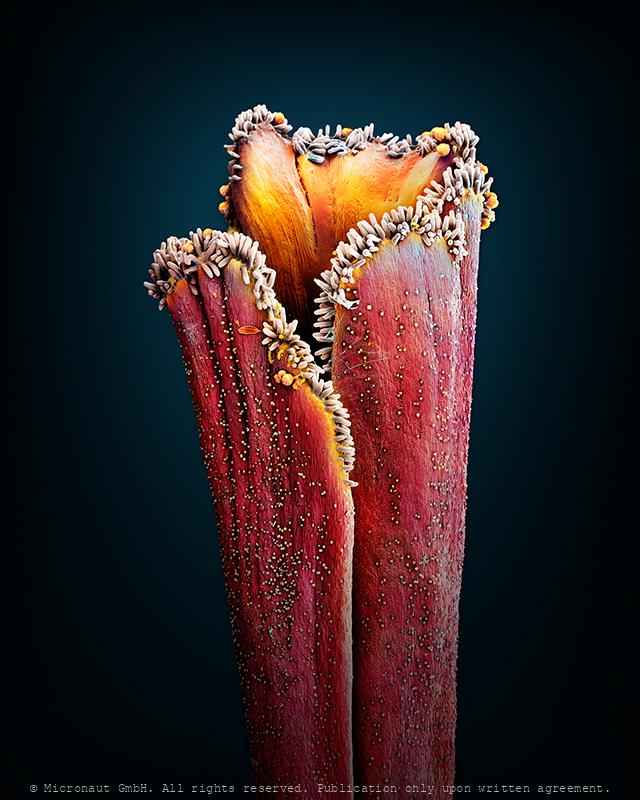
Saffron pistil (Crocus sativus)
Saffron (Crocus sativus) pistil; manually colored 3D realistic scanning electron micrograph by Martin Oeggerli / Micronaut, 2018. Saffron is a spice derived from the flower of Crocus sativus, commonly known as the “saffron crocus”. The vivid crimson stigmas and styles, called threads, are collected and dried to be used mainly as a seasoning and colouring agent in food. Saffron, long among the world’s most costly spices by weight, was probably first cultivated in or near Greece. Its recorded history is attested in a 7th-century BC and it has been traded and used for over four millennia. Iran now accounts for approximately 90% of the world production of saffron.Saffron’s taste and iodoform or hay-like fragrance result from the chemicals picrocrocin and safranal. It also contains a carotenoidpigment, crocin, which imparts a rich golden-yellow hue to dishes and textiles. Saffron contains more than 150 volatile and aroma-yielding compounds. It also has many nonvolatile active components, many of which are carotenoids, including zeaxanthin, lycopene, and various α- and β-carotenes. However, saffron’s golden yellow-orange colour is primarily the result of α-crocin.
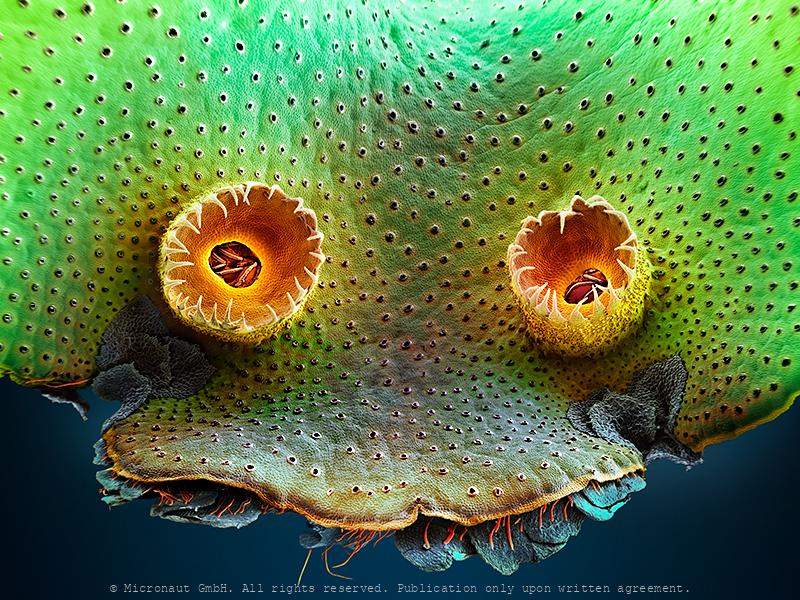
The most primitive plant on earth - Liverwort (Marchantia polymo
LIVERWORTS are untypical non-vascular plants. They look very much like flattened moss, and measure only between 2-20mm. Due to the small size, liverworts are often overlooked, despite there are about 9.000 species. As a gardener you may wondered how they sometimes become so widely established in your greenhouse - here's why: a) The flat green leaf-like body of the liverwort spreads horizontally across the media surface by dividing into two branches at apical notches. Each apical notch contains a growing-point (called 'meristem'), that can growth laterally if there is media to grow on. Fragments that are dislodged or torn away from the mother plant then have the potential to become independent new plants. b) In addition, the upper surface of the liverwort features 3-4mm cup-like structures called gemma cups. They contain over 100 tiny, disk-shaped gemmae, which represent clones of the mother plant. When water droplets hit the cups, the tiny gemmae are propelled out, sometimes up to 15 cm in the air, and each gemmae can eventually develop into a new plant if the conditions of living fit. c) Finally, liverworts which are either male or female plants, can also spread through sexual reproduction. In the presence of water, sperm may swim from the male plant up on a nearby female structure and fertilize the ovum which develops into a spore that will be eventually be spread by air currents. Female plants produce spores in the thousands and they are very small (less than 3.5µm in diameter). Starting with Greek philosophers such as Aristotle and Theophrastus, liverworts have been mentioned in the herbal literature (in many cases as 'lichen'). In the Middle Ages in Europa the species Marchantia polymorpha was thought to be useful for treating diseases of the liver, based on the plants morphologically which resembles the human organ. Nowadays, liverworts are an interesting topic in modern research, because they stand at the very beginning of the plant tree of life and com
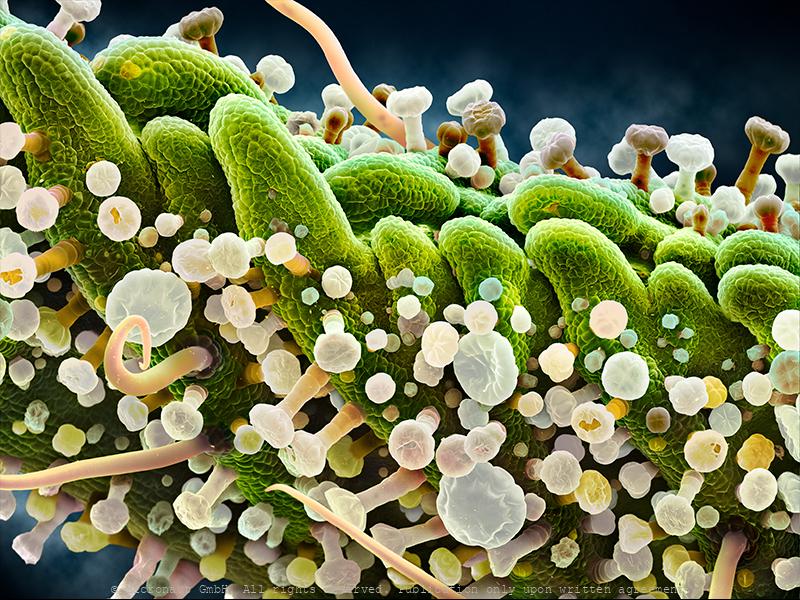
Wonderland Forest - The Walnut Leaf (Juglans sp.)
Under the powerful magnification of a scanning electron microscope (SEM), the leaf of a Walnut (XY sp.) looks like a forest location in Wonderland. And much like the forest in Wonderland it is so huge that it never seems to end for its many bizarre micro-organisms that tend to get lost there. And should it end at one point - at the edge of the leaf - it will continue on the next leaf, et cetera. If you look close, whatsoever, this micro-forest consists of glands and leaf hairs (trichomes) rather than bushes and trees. Glandular trichomes are multicellular secretory structures on the leaf surface which are able to synthesize and store various chemical compounds in order to protect the plant (leaf) from herbivorous insects, fungi, pathogens, extensive light, high temperature, and even UVB radiation. In Juglans regia you can find thousnads of these especially on the emerging (young) leafs. Many of these chemicals are medically relevant and thus, Junglans regia has been widely used in traditional medicine for very different ailments including: helminthiasis, diarrhea, sinusitis, stomachache, arthritis, asthma, eczema, scrofula, skin disorders, and various endocrine diseases such as diabetes mellitus, anorexia, thyroid dysfunctions, cancer and infectious diseases. by Martin Oeggerli and Louisa Howard, Microscopy Facility, Dartmouth College.
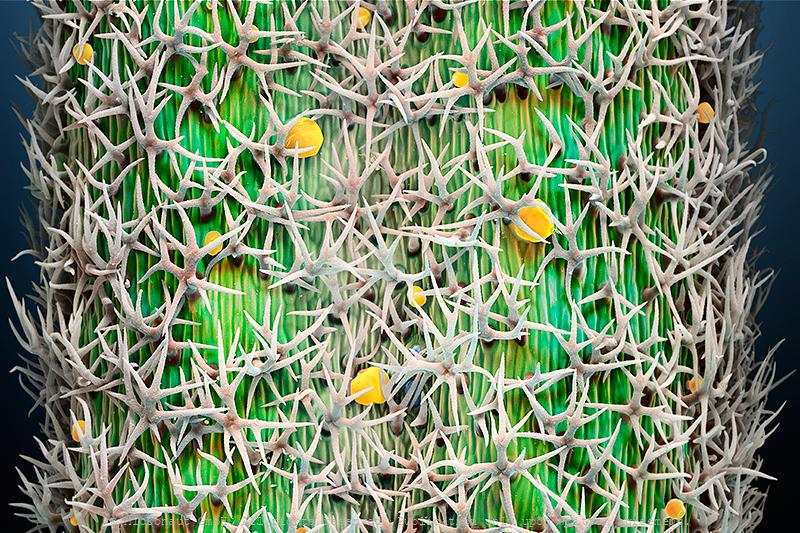
Lavender leaf (Lavendula angustifolia)
History: Use of lavender by humans has a long tradition: during Roman times, flowers were sold for 100 denarii per pound, which was about the same as a month's wages for a farm laborer, or fifty haircuts from the local barber. Its name comes from latin 'lavanda' (things to be washed). Culinary use: Flowers also yield abundant nectar from which bees make a high-quality honey. Monofloral honey is produced primarily around the Mediterranean, and is marketed worldwide as a premium product. Flowers can be candied and are sometimes used as cake decorations. Lavender flavors baked goods and desserts (it pairs especially well with chocolate), as well as used to make "lavender sugar". Lavender flowers are occasionally blended with black, green, or herbal tea, adding a fresh, relaxing scent and flavor. Lavender lends a floral and slightly sweet flavor to most dishes, and is sometimes paired with sheep's-milk and goat's-milk cheeses. For most cooking applications the dried buds (also referred to as flowers) are used, though some chefs experiment with the leaves as well. Only the buds contain the essential oil of lavender, which is where the scent and flavor of lavender are best derived. The French are also known for their lavender syrup, most commonly made from an extract of lavender. In the United States, both French lavender syrup and dried lavender buds make lavender scones and marshmallows. Oil: Commercially the plant is grown mainly for the production of essential oil of lavender. This has antiseptic and anti-inflammatory properties. These extracts are also used as fragrances for bath products. English lavender (Lavandula angustifolia) yields an essential oil with sweet overtones, and can be used in balms, salves, perfumes, cosmetics Health and Medical uses: Lavender is used extensively with herbs such as chamomile and aromatherapy. Infusions are believed to soothe insect bites, burns, and headaches. Bunches of lavender repel insects. In pillows, lavender seeds an
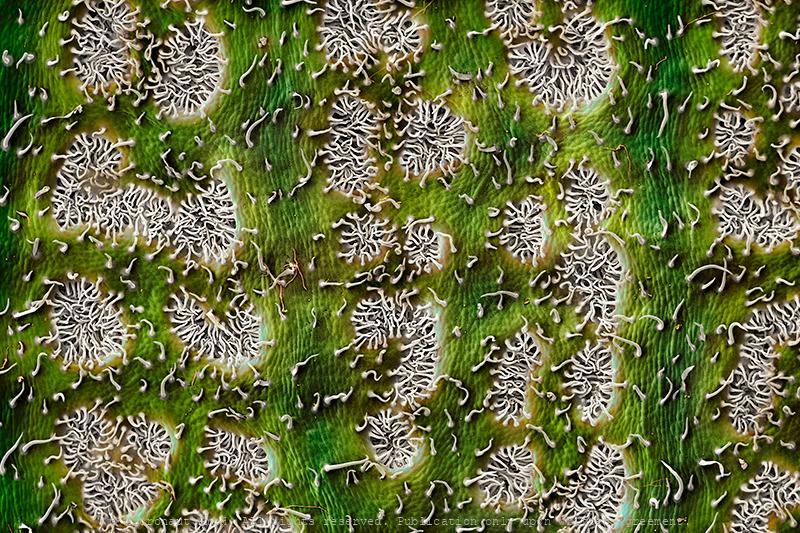
Peaceful Wilderness - The Oleander Leaf (Nerium oleander)
Under the powerful magnification of the scanning-electron-microscope (SEM), familiar objects turn into alien landscapes: this picture shows an ordinary oleander (Nerium oleander) leaf which is an every-day plant that can be found across the mediterranean and also throughout northern Europe, due to an increasing popularity among gardeners. While contemporary natural landscapes have been colonized and domesticized on a global scale over the past decades, this peaceful place on an Oleander leaf appears to have completely escaped contamination by human intervention - despite actually being part of it. The plant grows in a small bead & breakfast lodge close to the city of Basel, Switzerland.
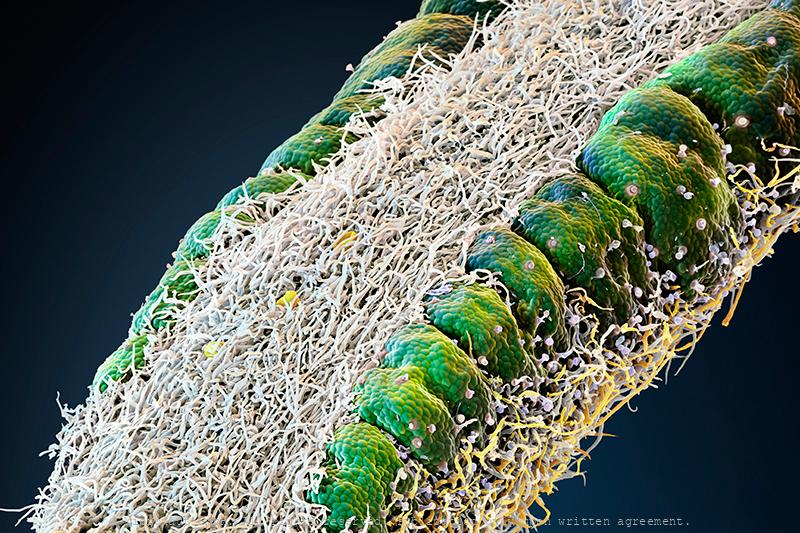
Dew of the Sea
Rosemary (Rosmarinus officinalis) leaf area. Hand-colored scannin electron micrograph. Rosemary is a woody evergreen shrub with leaves similar to hemlock needles, and white, pink, or blue flowers. It is native to the Mediterranean and Asia, but is reasonably hardy in colder climates. It has a fibrous root system and can withstand droughts, surviving a severe lack of water for lengthy periods. Forms range from upright to trailing; the upright forms can reach 1.5 m (5 ft) tall. Rosemary is a member of the mint family Lamiaceae, which includes many other herbs. The name "rosemary" derives from the Latin for "dew" (ros) and "sea" (marinus), or "dew of the sea". Upon cultivation, the leaves, twigs, and flowering apices are extracted for use. Rosemary is also used as a decorative plant in gardens where it may have pest control effects. The leaves are used to flavor various foods, such as stuffing and roast meats. Fresh or dried leaves have a bitter, astringent taste and a characteristic aroma. Herbal tea can be made from the leaves. Rosemary oil is used for purposes of fragrant bodily perfumes or to emit an aroma into a room. Rosemary contains a number of phytochemicals, including rosmarinic acid, camphor, caffeic acid, ursolic acid, betulinic acid, carnosic acid, and carnosol. Rosemary essential oil contains 10–20% camphor. The plant has been used as a symbol for remembrance during war commemorations and funerals in Europe and Australia. Mourners would throw it into graves as a symbol of remembrance for the dead. In Shakespeare's Hamlet, Ophelia says, "There's rosemary, that's for remembrance."
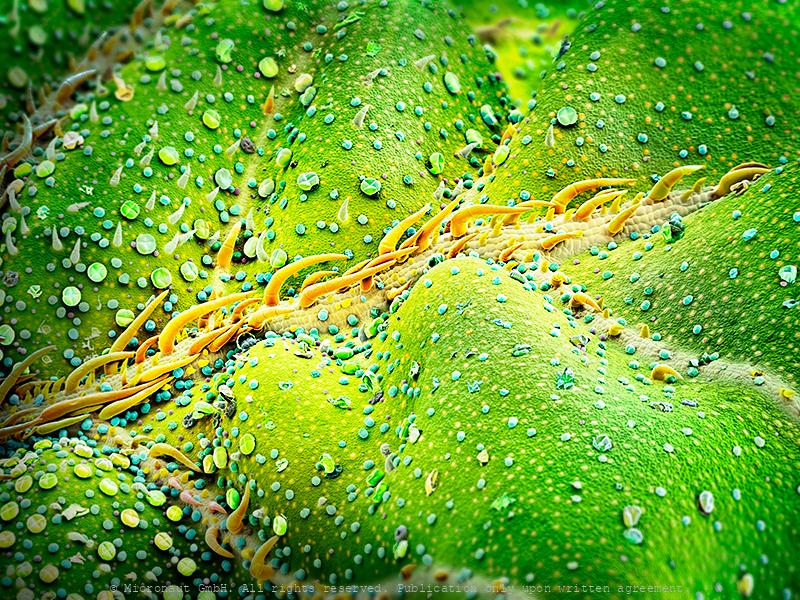
Basil leaf (Ocium basilicum)
The word basil comes from the Greek, meaning 'king'. Basil is possibly native to India, and has been cultivated there for more than 5,000 years. It is a culinary herb prominently featured in Italian cuisine, and also plays a major role in Southeast Asian cuisines of Indonesia, Thailand, Malaysia, Vietnam, Cambodia, Laos, and Taiwan. Basil is commonly used fresh in cooked recipes. In general, it is added at the last moment, as cooking quickly destroys the flavor. The various basils have such different scents because the herb has a number of different essential oils that come together in different proportions for various breeds. The strong clove scent of sweet basil is derived from eugenol, the same chemical as actual cloves. The citrus scent of lemon basil and lime basil reflects their higher portion of citral. African blue basil has a strong camphor smell because it contains camphor and camphene in higher proportions. Licorice basil contains anethole, the same chemical that makes anise smell like licorice, and in fact is sometimes called "anise basil." Chemicals produced by various basils include: citronellol, linalool, myrcene, pinene, ocimene, terpineol, linalyl acetate, fenchyl acetate, trans-ocimene, 1.8-cineole, camphor octanane, methyl eugenol, methyl chavicol, eugenol, beta-caryophyllene
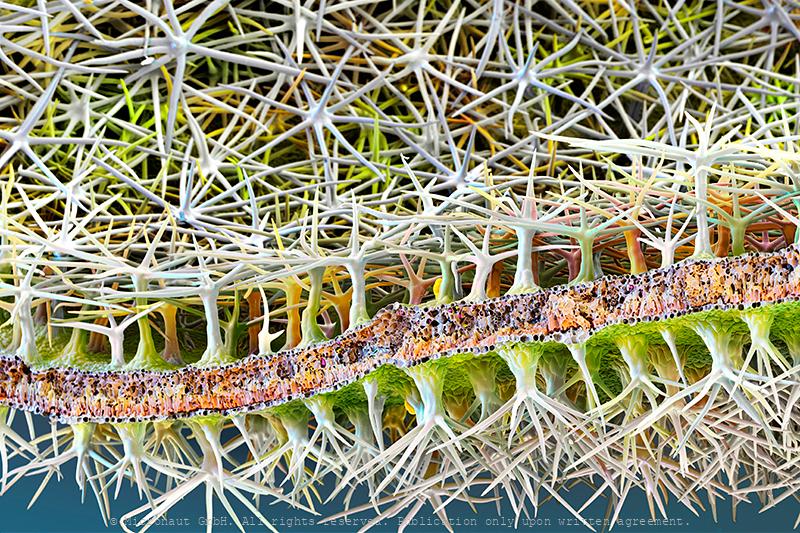
Nightshade stars (Solanum pyrocanthos)
Nightshade stars - Star-shaped prickles, developing from furry trichomes, densely coat the leaves and stems of the Porcupine tomato. The Porcupine Tomato, Solanum pyrocanthos, belongs to a diverse and cosmopolitan family of plants (Solanaceae) with over 1,500 members including the tomato, potato and nightshades. The plant contains various toxic tropane alkaloids in its leaves, stem and fruit and therefore should be considered dangerous to humans. Strong and straight fluorescent orange thorns occupy the stems and leaves of the plant (not shown on image), giving it a foreboding appearance. The prickles are consistent throughout the plant, developing clearly from furry trichomes which densely coat the plant's leaves (on both sides) and stems.
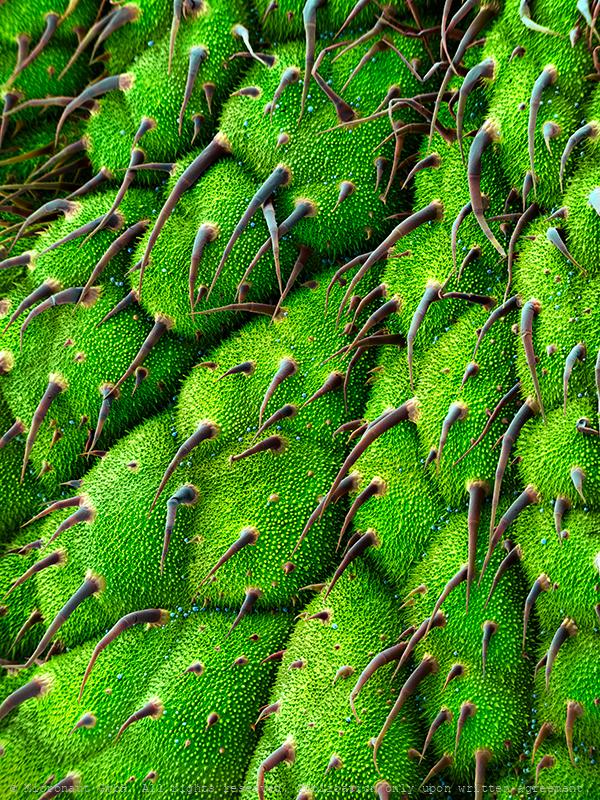
Lemon balm leaf (Melissa officinalis)
Hand-colored Scanning Electron Micrograph (SEM) of the Lemon balm (Melissa officinalis) leaf surface by Martin Oeggerli. Lemon balm is a perennial herb from the mint family, native to south-central Europe. Leaves, which have a mild lemon aroma, are used to make tea and medicine since 16th century. They have a mild lemon scent similar to mint, and are used for digestive problems, including: upset stomach, bloating, intestinal gas (flatulence), vomiting, and colic. Additional Lemonbalm can be used to treat: pain (menstrual cramps, headache, toothache), for mental disorders (Alzheimer's disease, attention deficit-hyperactivity disorder, hysteria and melancholia), and to treat autoimmune disease involving the thyroid (Graves' disease), swollen airways, rapid heartbeat due to nervousness, high blood pressure, sores, tumors, and insect bites. Furthermore, Lemon balm leaf contains: eugenol, tannins, and terpenes, (+)-citronellal, 1-octen-3-ol, 10-α-cadinol, 3-octanol, 3-octanone, α-cubebene, α-humulene, β-bourbonene, caffeic acid, caryophyllene, caryophyllene oxide, catechin, chlorogenic acid, cis-3-hexenol, cis-ocimene, citral A, citral B, copaene, δ-cadinene, eugenyl acetate, γ-cadinene, geranial, geraniol, geranyl acetate, germacrene D, isogeranial, linalool, luteolin-7-glucoside, methylheptenone, neral, nerol, octyl benzoate, oleanolic acid, pomolic acid ((1R)-hydroxyursolic acid), protocatechuic acid, rhamnazin, rosmarinic acid, stachyose, succinic acid, thymol, trans-ocimene and ursolic acid. Rosmarinic acid appears to be the most important active component, but the interaction with all other chemicals remains poorly understood.
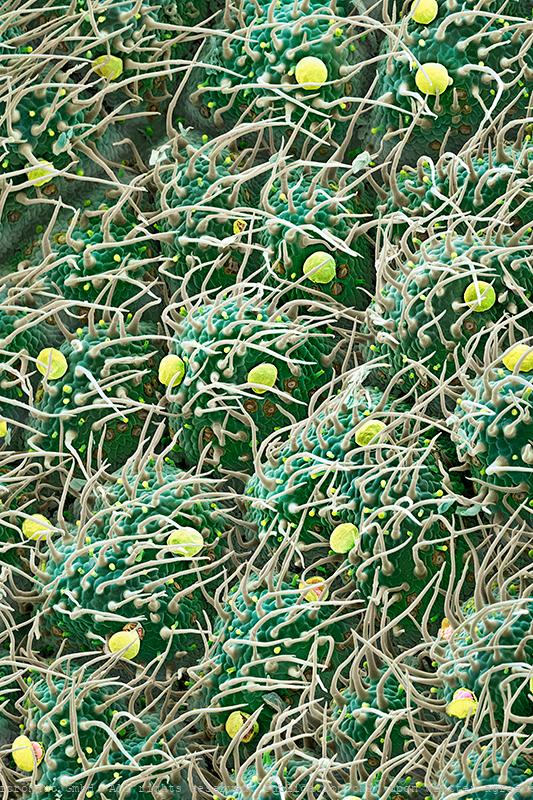
Sage leaf (Salvia officinalis)
Highly magnified hand-colored leaf area of Sage (Salvia officinalis) by Martin Oeggerli / Micronaut. Salvia officinalis is a perennial, evergreen subshrub, with woody stems, grayish leaves, and blue to purplish flowers. It is a member of the mint family Lamiaceae and native to the Mediterranean region. Sage is well known as a herb, and has a long history of medicinal and culinary use. The leafs are containing aetheric oils which are stored in thousands of smaller and larger secretory glands. Sage leafs contain tannic acid, oleic acid, ursonic acid, ursolic acid, carnosol, carnosic acid, fumaric acid, chlorogenic acid, caffeic acid, niacin, nicotinamide, flavones, flavonoid glycosides, and estrogenic substances, and are often used to make medicine for digestive problems, including loss of appetite, gas (flatulence), stomach pain (gastritis), diarrhea, bloating, and heartburn. Sage is also used for reducing overproduction of perspiration and saliva; and for depression, memory loss, and Alzheimer's disease. Women use sage for painful menstrual periods, to correct excessive milk flow during nursing, and to reduce hot flashes during menopause. Sage is applied directly to the skin for cold sores; gum disease (gingivitis); sore mouth, throat or tongue; and swollen, painful nasal passages. Some people inhale sage for asthma. In foods, sage is used as a commonly used spice. Scanning electron microscopy of sage leaves confirmed the presence of two basic types of glandular trichomes (capitate stalked, capitate sessile with one and with eight secretory cells). Gas liquid chromatographic analysis of the oil content of both gland types indicate only minor quantitative differences in essential oil composition. Thus, each gland type is capable of producing the four major monoterpene families (p-menthanes, pinanes, bornanes and thujanes) characteristic of sage.
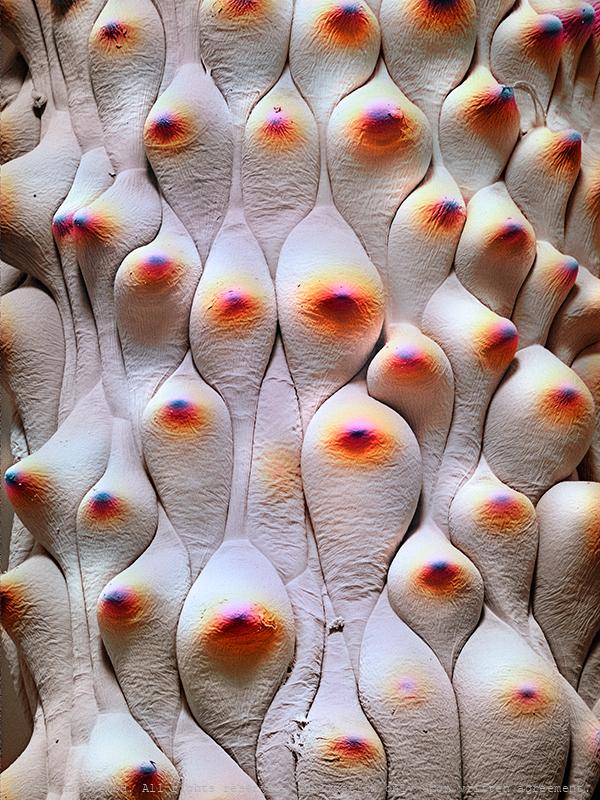
Martian Landscape (Loasa tricolor)
As protection for the ovaries, the gynoeceum wall of Loasa tricolor reveals similarities with a bouncy castle. Analysed under high magnification, many plant surfaces remind us on martian landscapes. Oeggerli slowly breathes life into his works by painstakingly selecting and masking different structures with color, layer upon layer utilizing his laptop touchpad. It is a slow manual process which allows him to set focus on mysterious microscopic structures which look almost extra-terrestrial.
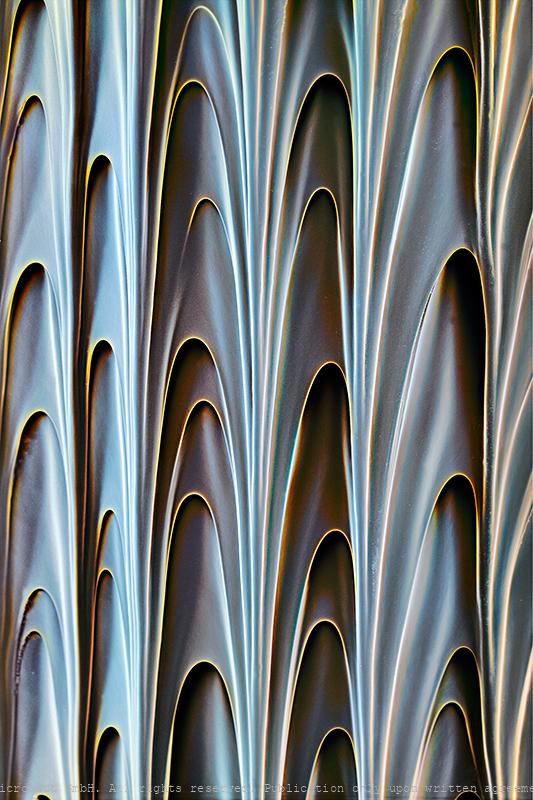
Pitcher plant (Nepenthes hemsleyana), Nr.1
Hand colored scanning-electron micrograph by Martin Oeggerli (Micronaut), showing the slippery surface inside a pitcher plant. Nepenthes hemsleyana is a tropical pitcher plant endemic to Borneo, where it grows in peat swamp forest and heath forest. It appears to rely on a prey trapping strategy unlike other pitcher plants: Interestingly, N. hemsleyana seems to have co-evolved with Hardwicke's woolly bats (Kerivoula hardwickii) which commonly roost in the upper pitchers. Studies shows that the carnivorous plant attracts bats by possessing modified pitfall taps that increase the reflectivity of echolocation calls - bats benefit by finding roosting sites, and the plants gain by receiving nitrogen from bat guano. Unlike in closely related pitcher plants, the upper pitchers of N. hemsleyana feature an expanded waxy zone (this structure is shown in the image) and a watery, less viscoelastic pitcher fluid. The pitchers also appear to lack UV patterns and produce less nectar and odour attractants, which is not required to host the bats.
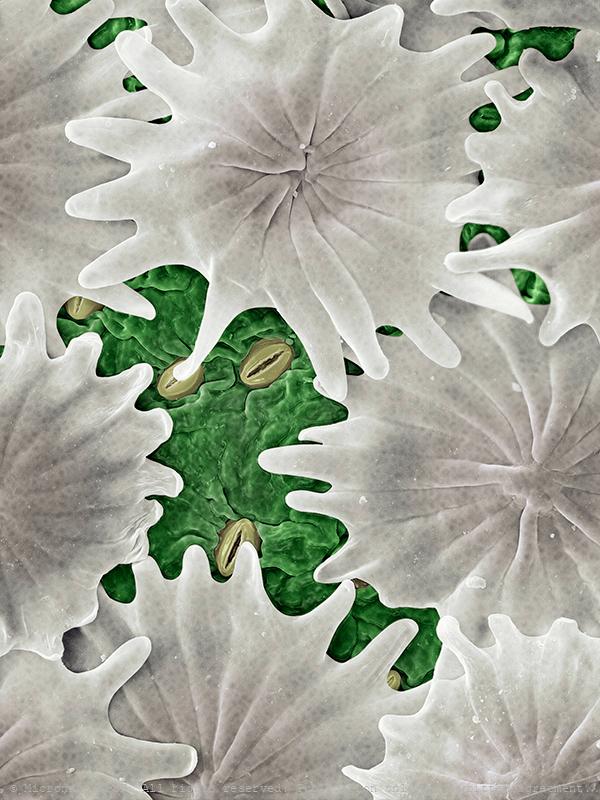
Olive leaf (Olea europaea), Nr.3
The surface of the olive tree leaf is covered by trichomes (hairs that resemble umbrellas). The function of the trichomes is to provide shade and safe water. They can also recycle water, which is lost during transpiration through the stoma.
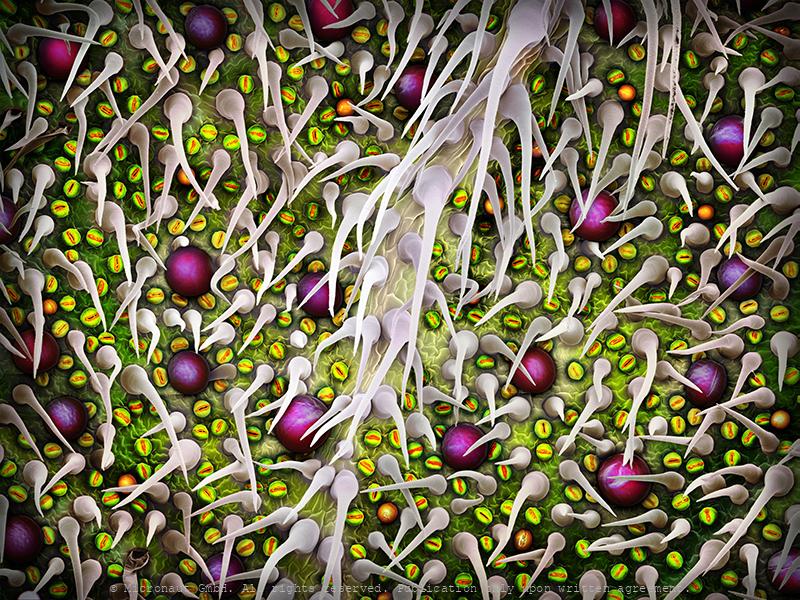
A Crowded Place
Cannabis leaf surface under very high magnification, visualizing the gland- and hair-structures (trichomes) of the plant leaf and flower area. Manually colored scanning-electron-micrograph by Martin Oeggerli / Micronaut. When it comes to cannabis, there is quite a bit more than what meets the naked eye. If you look at the flower you probably ask yourself about the tiny little structures that seem to cover the leaves and buds like a sticky blanket of frost. From close up, however, they appear to be large collections of what are known as trichomes. The word originates from the Greek word “Tríchōma”, meaning "growth of hair". Trichomes can be found in many plant species, taking on various physical forms as well as serving many different purposes. For example, trichomes found on some carnivorous plants aid in helping to catch prey. In cannabis, whatsoever, these microscopic mushroom-looking protuberances look like something out of a science fiction novel. In cannabis, the trichomes represent the very factories that produce hundreds of cannabinoids, terpenes, and flavonoids, which make our favorite cannabis strains potent, unique, and effective. In cannabis, trichomes have a dual function by serving as a chemical-defense mechanism to various insects and animals, due to the strong aromas and bitter taste, as well as to non-living environmental damage through UV rays and strong winds, due to the morphology and number of the trichome carpet. Trichomes exist in many shapes and sizes within the kingdom of plants, but there are just a few on cannabis plants: A - Bulbous trichomes are the smallest of the bunch, and they appear on the surface of the entire plant. Bulbous trichomes are as small as 10-15 micrometers, which is tiny enough to only be comprised of a handful of cells. B - Capitate sessile trichomes are slightly larger and contain both a head and a stalk. These trichomes are quite a bit more abundant than their bulbous brethren, but cannot hold a candle to
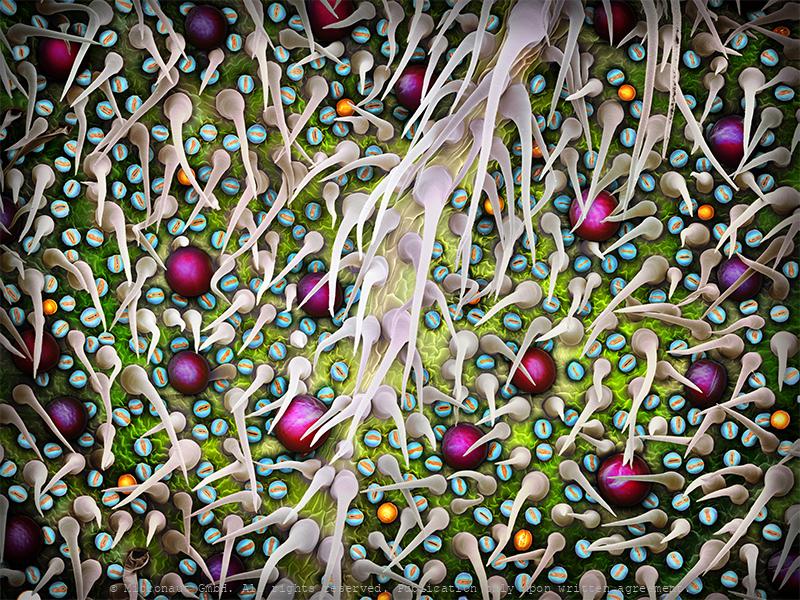
A Crowded Place
Cannabis leaf surface under very high magnification, visualizing the gland- and hair-structures (trichomes) of the plant leaf and flower area. Manually colored scanning-electron-micrograph by Martin Oeggerli / Micronaut. When it comes to cannabis, there is quite a bit more than what meets the naked eye. If you look at the flower you probably ask yourself about the tiny little structures that seem to cover the leaves and buds like a sticky blanket of frost. From close up, however, they appear to be large collections of what are known as trichomes. The word originates from the Greek word “Tríchōma”, meaning "growth of hair". Trichomes can be found in many plant species, taking on various physical forms as well as serving many different purposes. For example, trichomes found on some carnivorous plants aid in helping to catch prey. In cannabis, whatsoever, these microscopic mushroom-looking protuberances look like something out of a science fiction novel. In cannabis, the trichomes represent the very factories that produce hundreds of cannabinoids, terpenes, and flavonoids, which make our favorite cannabis strains potent, unique, and effective. In cannabis, trichomes have a dual function by serving as a chemical-defense mechanism to various insects and animals, due to the strong aromas and bitter taste, as well as to non-living environmental damage through UV rays and strong winds, due to the morphology and number of the trichome carpet. Trichomes exist in many shapes and sizes within the kingdom of plants, but there are just a few on cannabis plants: A - Bulbous trichomes are the smallest of the bunch, and they appear on the surface of the entire plant. Bulbous trichomes are as small as 10-15 micrometers, which is tiny enough to only be comprised of a handful of cells. B - Capitate sessile trichomes are slightly larger and contain both a head and a stalk. These trichomes are quite a bit more abundant than their bulbous brethren, but cannot hold a candle to
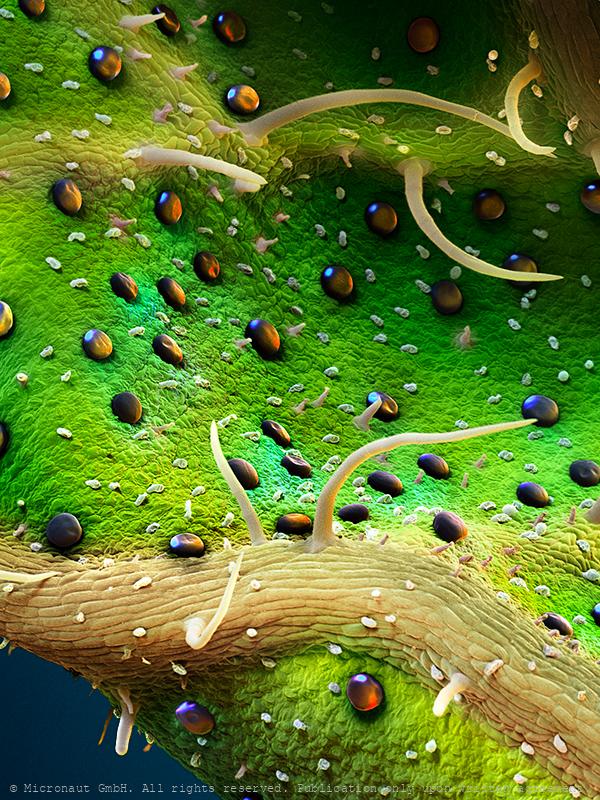
Oli-filled glands on a leaf
Hand-colored scanning electron micrograph (SEM) created by Martin Oeggerli. This images shows oil-filled glands on a Peppermint (Mentha piperita) leaf. Mints are widely distributed aromatic herbs. Most species grow best in wet environments and moist soils, growing between 10–120 cm tall. The most popular mints for commercial usages are peppermint (Mentha × piperita), native spearmint (Mentha spicata), Scotch spearmint (Mentha x gracilis), and cornmint (Mentha arvensis). The culinary source of mint are fresh or dried leafs. In the visually predominant peltate glandular trichomes, the secretion is stored in an enlarged subcuticular cavity, which gives these oil-filled glands their glossy bulbous appearance. Both, peltate and capitate glandular trichomes produce secretions containing monoterpenes. Peltate glandular trichomes have eight secretory cells on top of one stalk cell and one basal cell, whereas the much smaller capitate (pale bright appearance) glandular trichomes have just one secretory cell, one stalk cell and one basal cell. Non-glandular trichomes (i.e. "hairs") appear much more elongated and contain no aromatic substances. The substances that give the mints their characteristic aromas and flavors are menthol (the main aroma of peppermint and Japanese peppermint) and pulegone (in pennyroyal and Corsican mint). The compound primarily responsible for the aroma and flavor of spearmint is L-carvone. Mint leaves are used in teas, beverages, jellies, syrups, candies, and ice creams. In Middle Eastern cuisine, mint is used in lamb dishes, while in British cuisine and American cuisine, mint sauce and mint jelly are used, respectively. Additionally, mint essential oil and menthol are extensively used as flavorings in breath fresheners, drinks, antiseptic mouth rinses, toothpaste, chewing gum, desserts, and candies, such as mint (candy) and mint chocolate. Finally, mint oil is also used as an environmentally friendly insecticide for its ability to kill
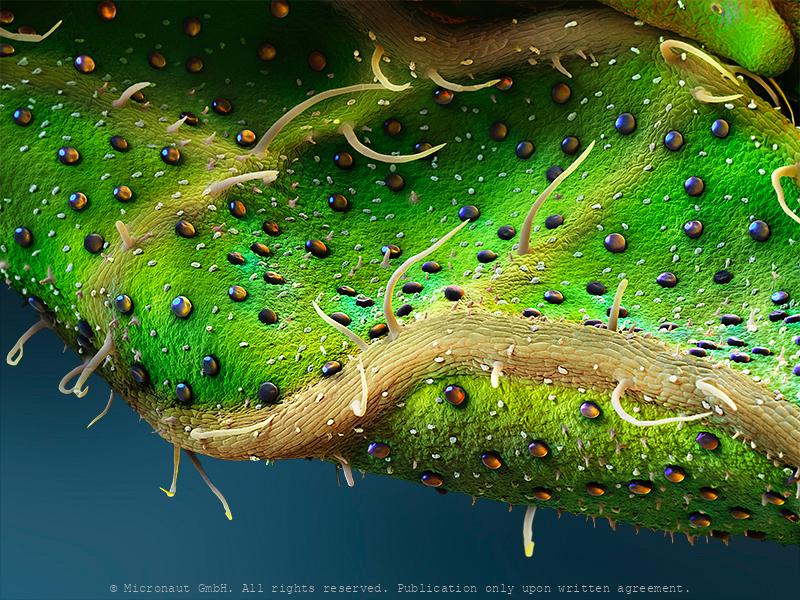
Oli-filled glands on a leaf
Hand-colored scanning electron micrograph (SEM) created by Martin Oeggerli. This images shows oil-filled glands on a Peppermint (Mentha piperita) leaf. Mints are widely distributed aromatic herbs. Most species grow best in wet environments and moist soils, growing between 10–120 cm tall. The most popular mints for commercial usages are peppermint (Mentha × piperita), native spearmint (Mentha spicata), Scotch spearmint (Mentha x gracilis), and cornmint (Mentha arvensis). The culinary source of mint are fresh or dried leafs. In the visually predominant peltate glandular trichomes, the secretion is stored in an enlarged subcuticular cavity, which gives these oil-filled glands their glossy bulbous appearance. Both, peltate and capitate glandular trichomes produce secretions containing monoterpenes. Peltate glandular trichomes have eight secretory cells on top of one stalk cell and one basal cell, whereas the much smaller capitate (pale bright appearance) glandular trichomes have just one secretory cell, one stalk cell and one basal cell. Non-glandular trichomes (i.e. "hairs") appear much more elongated and contain no aromatic substances. The substances that give the mints their characteristic aromas and flavors are menthol (the main aroma of peppermint and Japanese peppermint) and pulegone (in pennyroyal and Corsican mint). The compound primarily responsible for the aroma and flavor of spearmint is L-carvone. Mint leaves are used in teas, beverages, jellies, syrups, candies, and ice creams. In Middle Eastern cuisine, mint is used in lamb dishes, while in British cuisine and American cuisine, mint sauce and mint jelly are used, respectively. Additionally, mint essential oil and menthol are extensively used as flavorings in breath fresheners, drinks, antiseptic mouth rinses, toothpaste, chewing gum, desserts, and candies, such as mint (candy) and mint chocolate. Finally, mint oil is also used as an environmentally friendly insecticide for its ability to kill
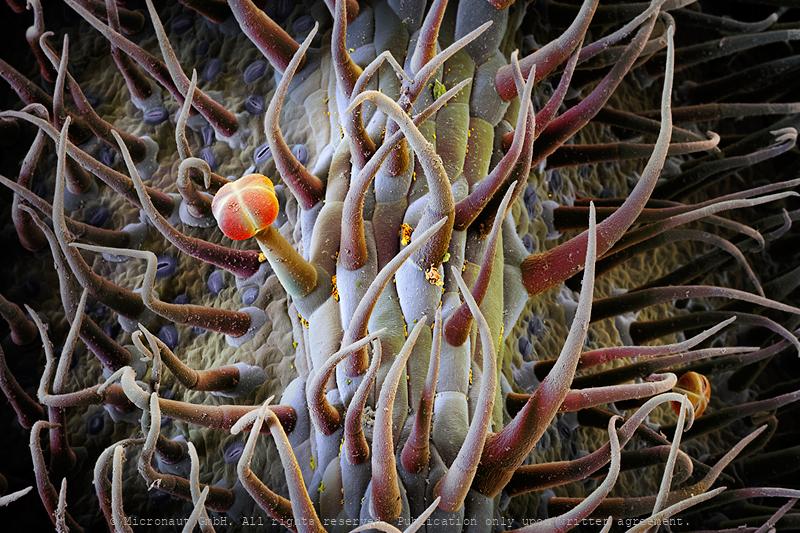
Tomato leaf (Lycopersicon esculentum)
Tomato leaf surface. Hand-colored scanning electron micrograph (SEM) of the surface of a tomato leaf (Lycopersicon esculentum) created by Martin Oeggerli. The picture is showing the complexity of a plant leaf area at invisibly small dimension. Scientists believe that the hairs and glands protect the plant against predators and reduce water loss through evaporation. Also visible are discretely grey-blue colored pores (stomata). They are responsible for the gaseous exchange: CO2 enters the leaf, while O2 and water are evaporated, thereby maintaining a constant flow of water from the roots, through the stem and branches, to the leafs. Glandular trichomes are a special type of 'hairs' and contain crystals and oils in the bulbous section of the structures. Two of these structures can be seen in the picture. It’s believed that the crystals and oils are part of the plant’s defense mechanisms. The essential oils are responsible for giving the tomato plant its characteristic smell. The volatile compounds of the oils that contribute that contribute to the typical scent of tomato leafs are (Z)-3-hexenal, limonene, hexanal, (E)-2-hexenal, eugenol, 1,8-cineole, caryophyllene, beta-phellandrene, humulene, and linalool. It’s a little ironic that what might be considered intoxicating to us can be so “unpleasant” to pests! Collectively, these compounds are exclusive to tomato trichomes.
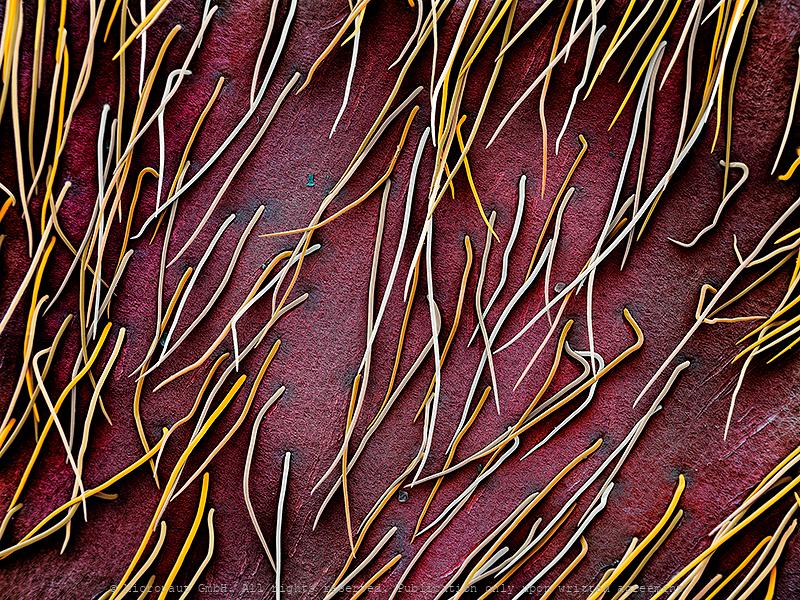
Rose Petal Surface, Nr.1
Lower surface of a Rose petal
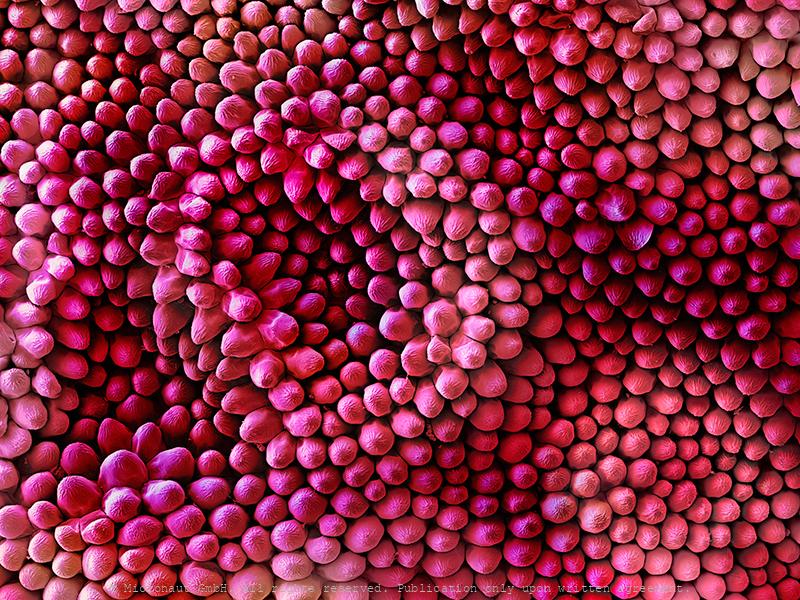
Velvet Underground (Rosa sp.)
Velvet UndergroundColored Scanning Electron Micrograph of the fine structures of a Red rose petal (Rosa sp.). Hairs are only present on the lower surface of the leaf. Thousands of finely corrugated warts cause the velvet shimmer on the upper surface of dark red rose petals.A superhydrophobic surface is a surface on which a drop of water forms an almost perfect sphere and even a very slight tilting is sufficient to cause the water drop to roll off. Biological tiny structures have been observed on many kinds of surfaces such as lotus leaves, rice leaves, butterfly wings, mosquito eyes, moth eyes, cicada wings, gecko feet, desert beetle, spider silks, fish scales, and red rose petals which exhibit excellent hydrophobicity and/or superhydrophobicity. Understanding the anti-wetting principles of surfaces is of special interest, because properties such as anti-sticking, anti-contamination, and self-cleaning are expected, and therefore surfaces with superhydrophobic properties are attractive for many industrial and biological applications, such as anti-biofouling paints for boats, anti-sticking and self-cleaning windshields and windows, microfluidics, stain resistant textiles, anti-soiling architectural coatings, or dust-free coatings on building glasses, and other biological and technical applications.
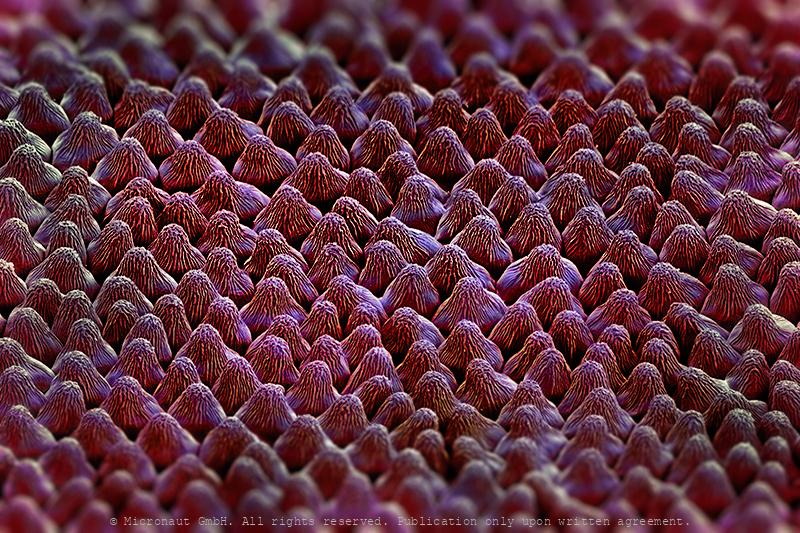
Velvet Underground - Rose petal Nr.2
Velvet UndergroundColored Scanning Electron Micrograph of the fine structures of a Red rose petal (Rosa sp.). Hairs are only present on the lower surface of the leaf. Thousands of finely corrugated warts cause the velvet shimmer on the upper surface of dark red rose petals.A superhydrophobic surface is a surface on which a drop of water forms an almost perfect sphere and even a very slight tilting is sufficient to cause the water drop to roll off. Biological tiny structures have been observed on many kinds of surfaces such as lotus leaves, rice leaves, butterfly wings, mosquito eyes, moth eyes, cicada wings, gecko feet, desert beetle, spider silks, fish scales, and red rose petals which exhibit excellent hydrophobicity and/or superhydrophobicity. Understanding the anti-wetting principles of surfaces is of special interest, because properties such as anti-sticking, anti-contamination, and self-cleaning are expected, and therefore surfaces with superhydrophobic properties are attractive for many industrial and biological applications, such as anti-biofouling paints for boats, anti-sticking and self-cleaning windshields and windows, microfluidics, stain resistant textiles, anti-soiling architectural coatings, or dust-free coatings on building glasses, and other biological and technical applications.
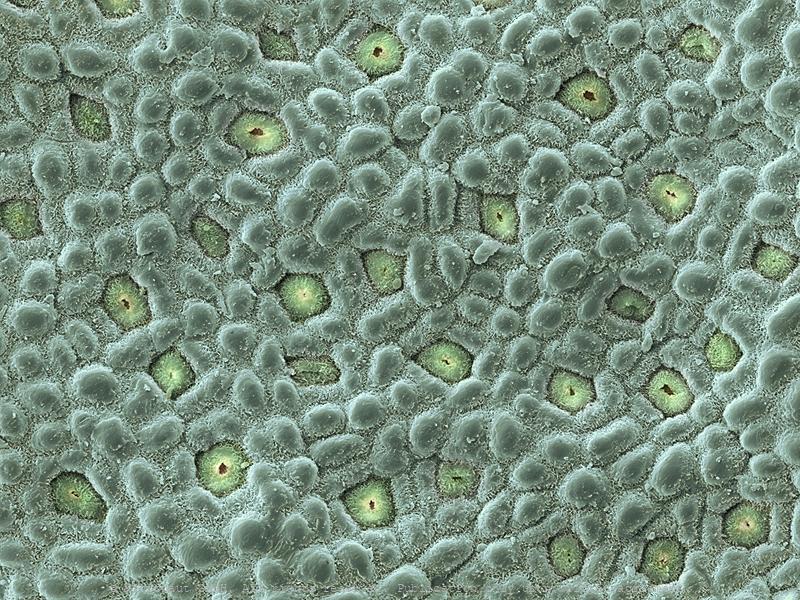
Eucalyptus leaf area
Eucalyptus leaf area
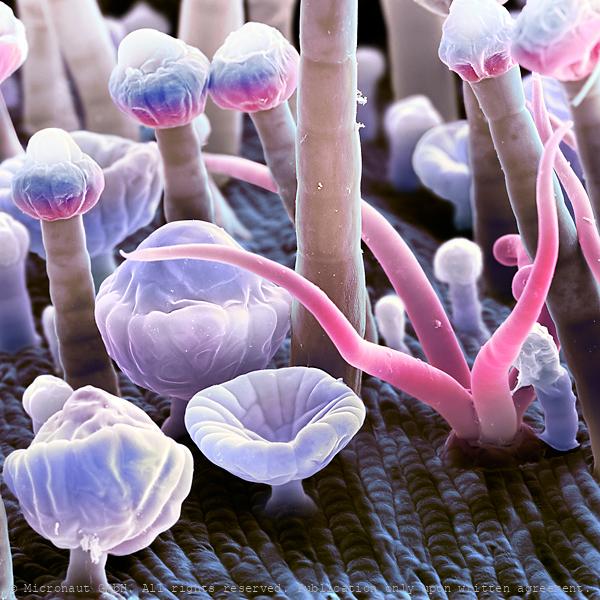
Walnut stem (Juglans niger), Nr.1
Drüsenhaare auf Walnuss Epidermis, trichomes on walnut epidermis
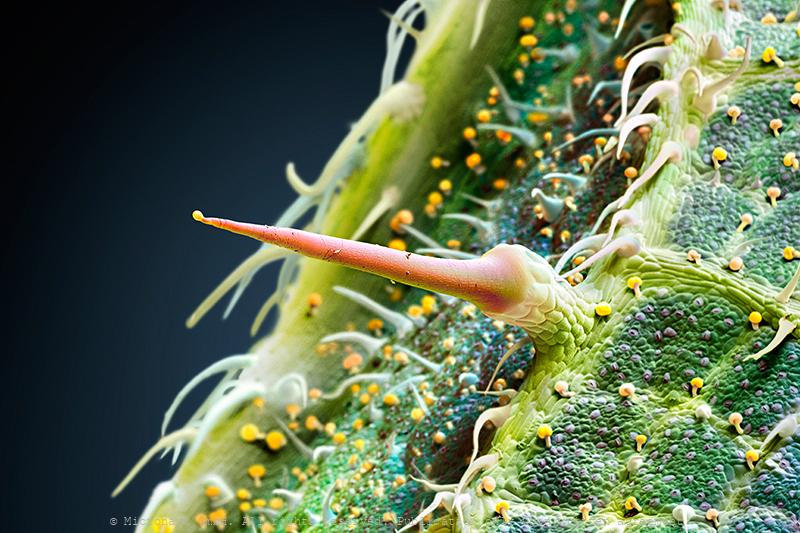
Stinging Nettle hair (Urtica dioica)
The Stinging Nettle (Urtica dioica) is a plant with soft green leafs that are equipped with glands as well as short non-stinging and special elongated stinging hairs (center), from which the species derives its common names: stinging nettle, burn nettle, burn weed, or burn hazel. Stinging hairs (trichomes) produce a painful stinging sensation by injecting a chemical mixture when touched by humans or other animals. They act like hypodermic needles: after the tip breaks off, a chemical mixture composed of histamine, acetylcholine, 5-HT (serotonin), moroidin, leukotrienes and formic acid is injected and causes pain or paresthesia. Furthermore, the plant has a long history of use in medicine, as food source (tea) and as source of fibre.
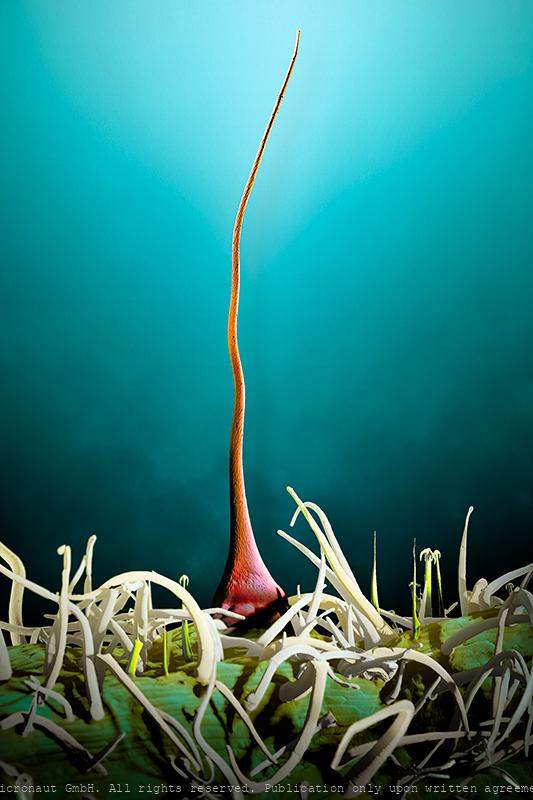
Stinging Vegetable Velcro (Eucnide bartonionides)
The Stingbush (Eudnide bartonionides) is a plant is a shrub which is native to desert areas in California, Arizona, Utah and Baja California. The leafs are equipped with short non-stinging ('velcro') hairs and special elongated stinging hairs (center). Stinging hairs (trichomes) produce a painful stinging sensation by injecting a chemical mixture when touched by humans or other animals. They act like hypodermic needles: after the tip breaks off, a chemical mixture composed of different chemicals that are injected and cause pain or paresthesia. Shorter 'velcro' hairs hold on your skin if you are touching the plant leaf, to increase damage and pain caused through elongated stinging hairs.
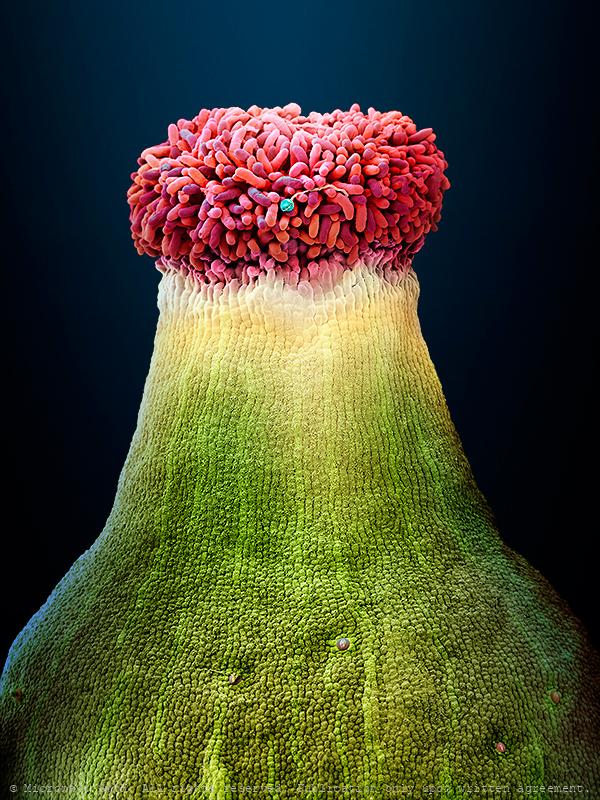
Erotic Adventures of the little Chardonnay pollen (Vitis sp.)
Pistil of a Chardonnay flower, including a pollen grain -placed in the central part of the stigma- that is growing a pollen tube. Chardonnay is a green-skinned grape variety used in the production of white wine. The variety originated in the Burgundy wine region of eastern France, but is now growing wherever wine is produced, from England to New Zealand. The Chardonnay grape itself is very neutral, with many of the flavors commonly associated with the grape being derived from such influences as terroir and oak. Chardonnay is also an important component of many sparkling wines, including Champagne. Modern DNA fingerprinting research suggests that Chardonnay is the result of a cross between the Pinot noir and Gouais blanc. The Romans are thought to have brought Gouais blanc from Croatia, and it was widely cultivated by peasants in eastern France. The Pinot of the French aristocracy grew in close proximity to the Gouais blanc, giving both grapes ample opportunity to interbreed.
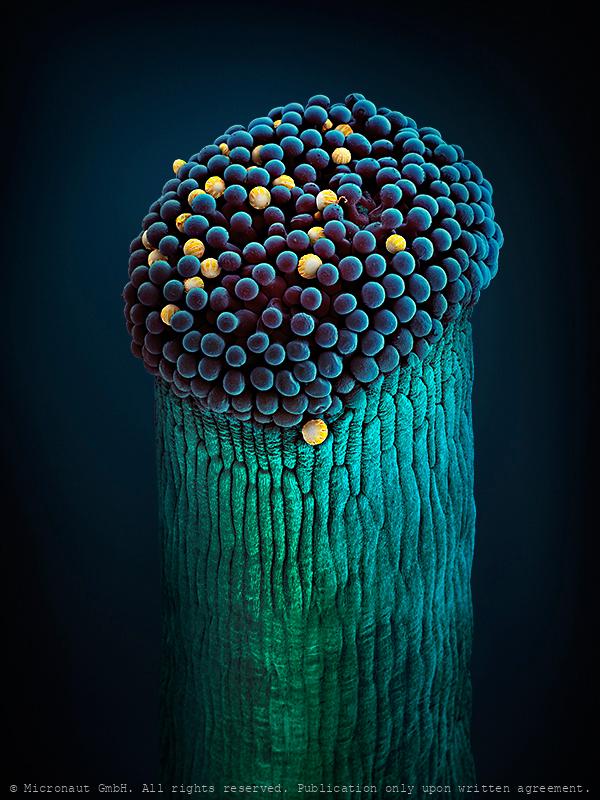
Borago (Borago officinalis) pistil
Borago (Borago officinalis) pistil with pollen, manually colored 3D realistic scanning electron micrograph by Martin Oeggerli / Micronaut, 2019. Paracelsus coined the famous dictum, “What is there that is not poison? All things are poison and nothing is without poison. Solely the dose determines that a thing is not a poison," and it is quite like that with the Borago: Food: Borago leaves are edible and the plant is grown in gardens for that purpose in some parts of Europe (Germany, Poland, Crete, Spain, Italy, and UK). The plant is also commercially cultivated for borage seed oil extracted from its seeds. Although often used in soups, one of the better known borage recipes is the Green Sauce (Grüne Soße) made in Frankfurt, Germany. In the Italian region of Liguria, borage is commonly used as a filling of the traditional pasta ravioli and pansoti. It is also used to flavour pickled gherkins in Poland. In the UK, Borago is traditionally used as a garnish in the Pimms Cup cocktail, but is nowadays often replaced by a long sliver of cucumber peel or by mint. It is also one of the key botanicals in Gilpin's Westmorland Extra Dry Gin. Medicine: Traditionally, Borago officinalis has been used in hyperactive gastrointestinal, respiratory and cardiovascular disorders, such as gastrointestinal (colic, cramps, diarrhea), airways (asthma, bronchitis), cardiovascular, (cardiotonic, antihypertensive and blood purifier), urinary (diuretic and kidney/bladder disorders). It can also be used to inhibit amoebical activity. Toxicity: The plant contains pyrrolizidine alkaloids, some of which are hepatotoxic, mutagenic and even carcinogenic due to the content of liver-toxic Pyrrolizidine alkaloids in the leaves (small amounts; 2-10 ppm of dried herb). Flower & Artwork: Borago flowers are most often blue, although pink flowers are sometimes observed, and white flowers have also been bread successfully.
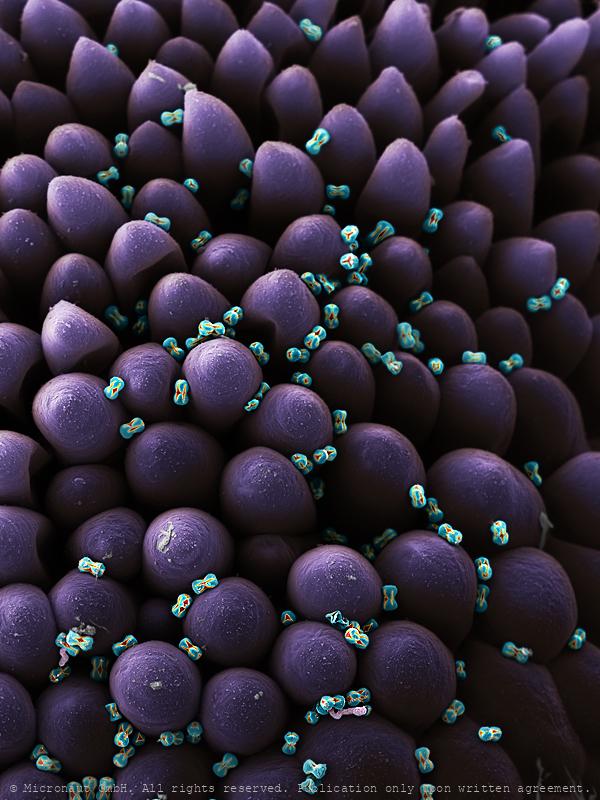
Forget me not pollen (Myosotis sylvatica), Nr.1
This image shows Forget-me-not (Myosotis sylvatica) pollen grains emerging from the anther. They are the smallest pollen grains worldwide, measuring only a little more than an E. coli bacterium.
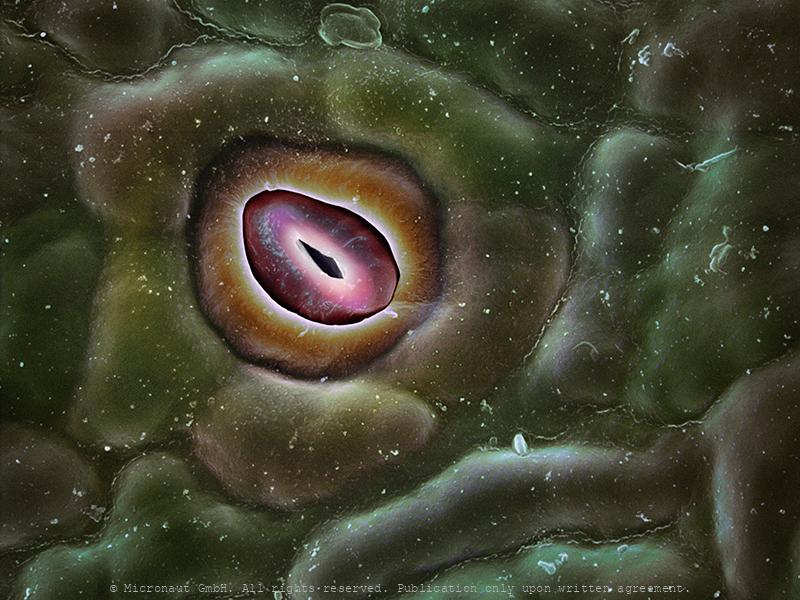
Keep breathing - Plant epidermis with open pore (called stoma)
Plants "breath" through stoma on the lower surface of their leafs. Each stoma can be opened or closed through regulations of the turgor pressure.
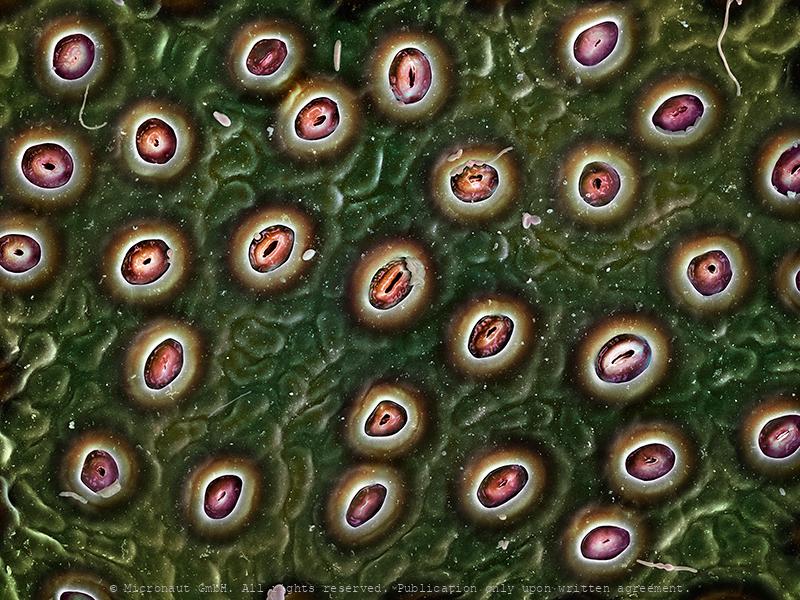
Ilex leaf (Ilex sp.), Nr.2
Plants "breath" through stoma on the lower surface of their leafs. Each stoma can be opened or closed through regulations of the turgor pressure.
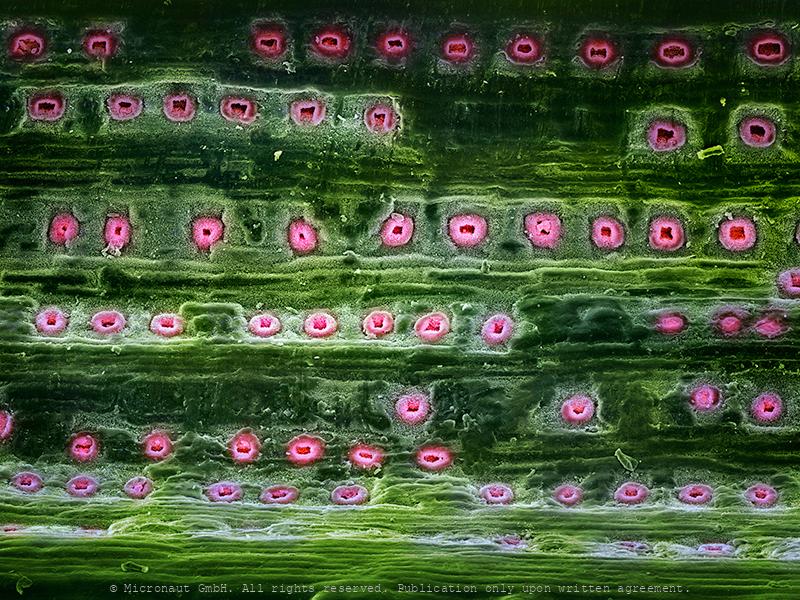
Conifer needle epidermis
Conifers have needles instead of leafs, which are also green and photosynthetically active. Depending on the species they persist 1.5-40 years and must be much more stably built than leafs of deciduous trees.
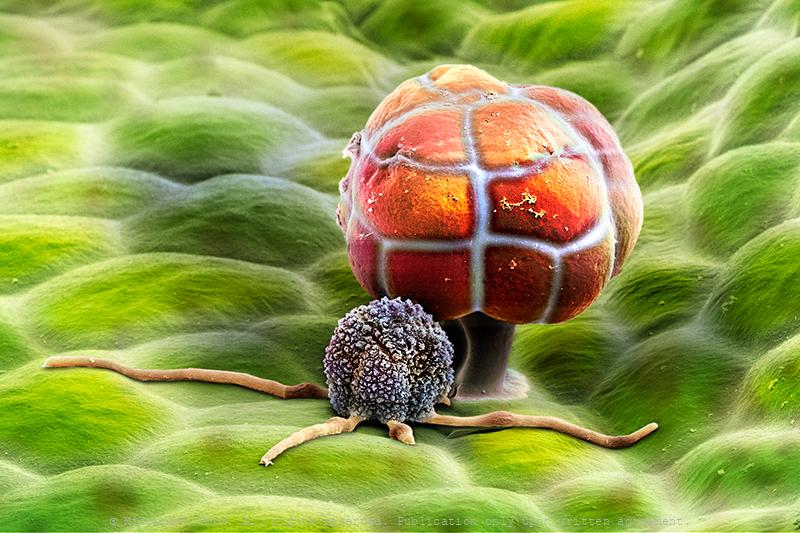
Germinating Fungus Spore (Original of Evil)
Artwork created by Martin Oeggerli (Micronaut). The picture is based on scanning-electron-microscopy technology, and all colors are manually added by the artist in post-production. Urera baccifera is a species of flowering plant in the nettle family known by many common names, including scratchbush, ortiga brava, pringamoza, mala mujer, chichicaste, nigua, guaritoto, ishanga, manman guêpes, and urtiga bronca. The tree can reach five meters in height. The thin, toothed leaves are up to 25 centimeters long and are covered by stinging hairs. On this leaf, a fungi spore rests under a bulbous gland. The parasite has already started to grow hyphae, eventually trying to invade the leaf.
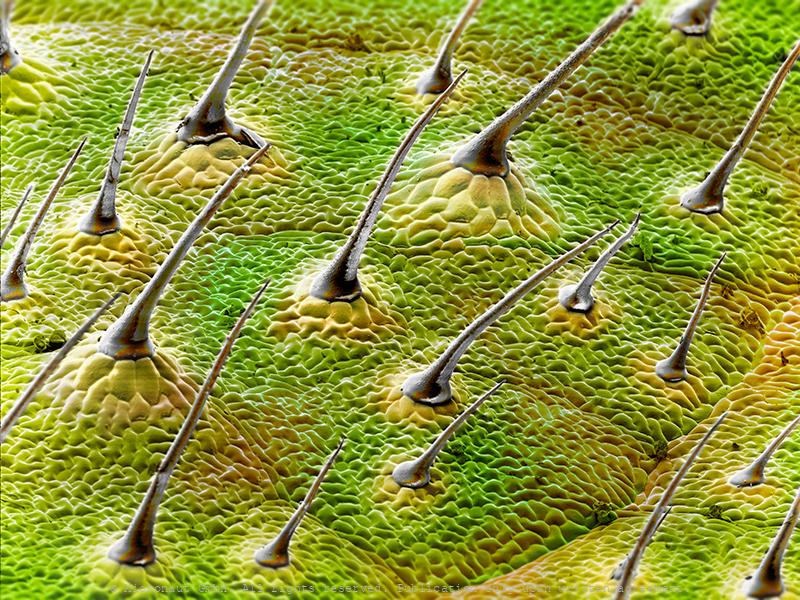
Leaf surface - Magnification makes you a stranger
Surface of a leaf with hairs
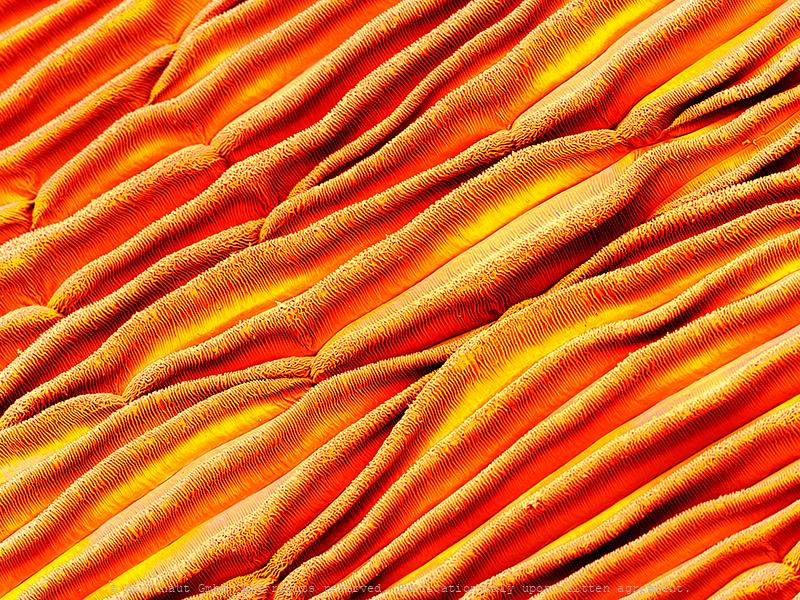
Spotlessly clean - Self cleaning properties of plants
Biological surfaces are usually not flat. Instead, most plants reveal complex three dimensional structures down to the nanometer range and often look highly ordered. It's an amazingly beautiful microscopic world. But what are the reasons behind? Plants are unable to move. To remain clean, they have to rely on self cleaning properties. Over millions of years, plants have developed sophisticated repellent structures, which also make sure leaf- and flower surfaces do not stick together, not even under wet circumstaces. In addition, flowers start as small buds and often unfurl immensly large petals within a short period of time. This extreme volume changes require special tissues that are both flexible and tear-resistant - similar to a parachute. In fact there are so many funtional reasons for the fascinating diversity of microscopic plant surfaces that it is impossible to mention all of them. Beyond that, nature often finds more than one solution to solve a problem. It only adds to the complexity for those trying to explore and understand the vast diversity of plant micro-structures.
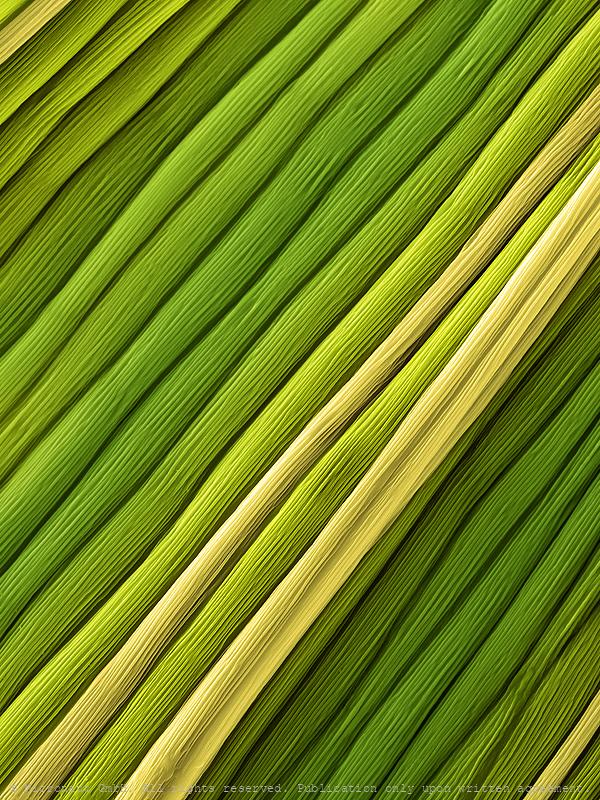
Flower landscape (Erica sp.)
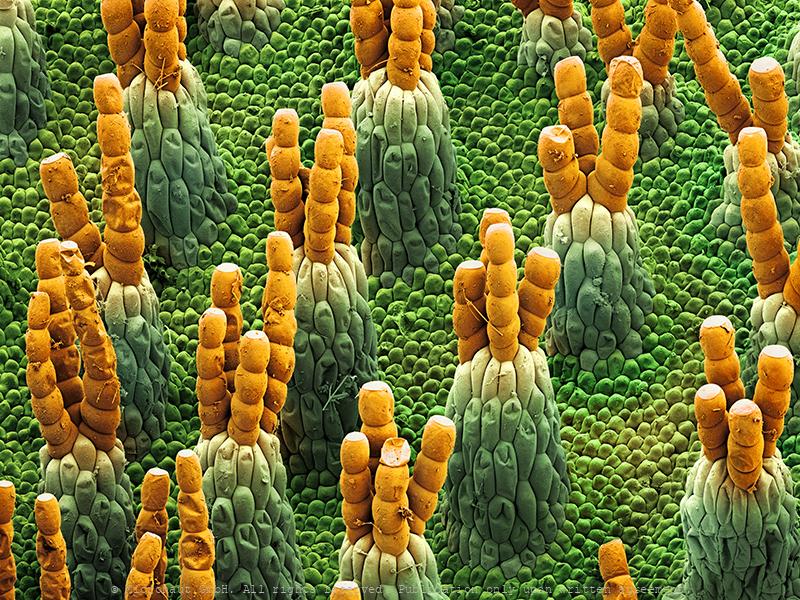
Waterrepellent micro-surface (Salvinia molesta)
Aquatic organisms possess structured surfaces which enable them to effectively retain air films while submerged in water. The transfer of these optimised hydrophobic structures on technological surfaces would open up a multitude of applications.
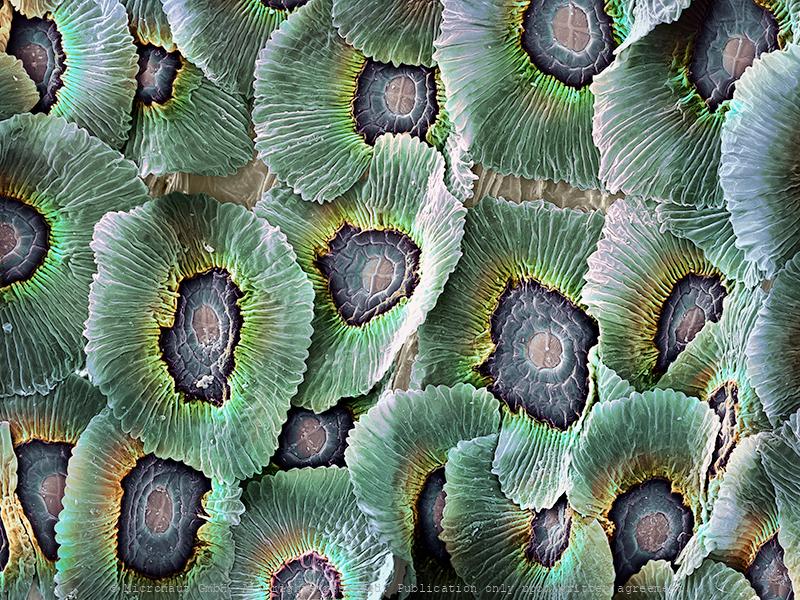
The epidermis of a tillandsia is covered with sucking hairs. The plant has reduced roots and is specialised on using fog as the primary source of water.
As water becomes a more and more scarce, it's interesting to look around and learn how nature is dealing with the exact same problem, and it reveals interesting techniques and structures. While some plant species such as e.g. Eucalyptus are covering the entire leaf area with a thick layer of wax, the Olive tree has developed flattened hairs on the leaf surface which resemble umbrellas to provide some extra shade for the leaf surface below. Yet the Tillandsia went one step further: the small epiphytic plant which has no roots and virtually no access to groundwater resources, uses special trichomes (which are called sucking hairs) to absorb water from moist air. The picture shows how trichomes cover the entire leaf area. It needs a unique solution to survive in an acrobatic environment.
